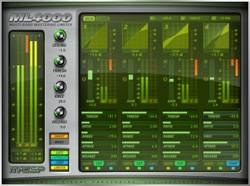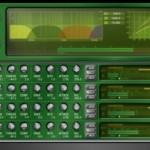
Deadly Bands of Destruction: Part 1

McDSP ML4000
So I’ve admittedly had an on-again/off-again relationship with the multiband compressor. I searched through my archives and while I’ve mentioned multibands in the past, I’ve never done anything specific on them. Over the last several months, I’ve noticed a lot of talk and hype about multiband comps, and they’ve sort of become the feature du jour in the latest digital consoles. Multibands can definitely be powerful tools, but they can also be an easy road to trouble. Today I’m going to start off a series of posts to lay out some of my thoughts related to multibands and where I land on them today after using them on and off in mixing for the last five years.
My first exposure to the multiband compressor was as a studio intern, and I’ll never forget what my mentor and boss at the time told me:
Multiband compressors are an easy way to really…errrr….mess…up a mix.
Well, honestly, he had a much more colorful way of explaining the dangers, but regardless, his words have stuck with me for almost 15 years now.
Now I dig compressors. Compressors can be a lot of fun, and the other day I was marveling at all the different compressor options I’ve acquired over the years. However, compressors can be difficult to master for novice mixers–see my post from a few years ago if you’re trying to figure them out. Compressors can do wonders in a mix, but they are also a dangerous piece of gear that can destroy audio which is clearly evidenced by many of the commercial recordings of the last decade or so. I think anyone interested in mixing needs to take the time to learn how to properly use a compressor, but they also need to respect the potential power of the unit.
Let’s review a quick bit about compressors:
* * * Live Sound 101 * * *
A compressor is basically an automatic fader. In general, the user sets a signal level threshold and when a signal rises above it, the compressor attenuates the signal in order to conform to a specified ratio either predetermined by the unit or set by the user. This essentially makes it harder for the signal to get louder past a certain point. The result of using a compressor is the average level of the signal is raised by making the louder bits not quite as loud. A compressor compresses the dynamic range of the signal.
One of the things we like about compressors is that a signal typically ends up being louder on the other side of the compressor. The box/plugin turns our signal down so we turn it up to compensate; some comps even do this automatically for us. However, this is also the problem with compressors and why they are so seductive: We like things loud and generally perceive louder to be better. The problem here is it’s easy to ignore compression side-effects and damage the compressor might be doing to a sound because often our brain immediately starts to rave about how good and cool and awesome it is because we perceive louder as better. Louder might seem better, but the reality is we also like sounds to be dynamic and overly limiting dynamic range is actually fatiguing to us over time. Compression can destroy transients and actually reduce definition when overused, but we often miss this because we’re enchanted by the loudness it gives us.
I’m sorry to be a pessimist on this, but I’ve been listening to a lot of records lately that could have been great if dynamic processing hadn’t been overused. I empathize with those mixers, though, because even I get this wrong from to time. Right now, the typical house of worship audio engineer has greater access to compressors than ever before thanks to the digital console boom, and if I can have one crusade it would be that we don’t fall into the same trap of overusing them that many recording folks have fallen into. I cringe when I read interviews with FOH engineers talking about emulating the compressed sound of today’s major label recordings.
I know some of you will need to do more damage than good to learn this for yourselves, however, my hope is that warnings like these can cut down on that number because whether we acknowledge it or not, there is a lot at stake every time we sit behind a console.
* * * End Live Sound 101 * * *
A multiband compressor is like the next level of compressor. These come to us courtesy of the dark recesses of the mastering studio. Where our traditional compressor affects an entire signal, the multiband compressor employs multiple compressors that each work on a specific frequency range of a signal. The typical multiband comps I see divide a signal into four frequency bands, however, there’s no reason there can’t be more or less and there’s also no reason you need to use all of the bands every time. Controls are typically the same as what you would find on a traditional compressor with additional controls to adjust the frequency crossover points between bands.
Traditionally, the multiband compressor was employed by mastering engineers as one of the final stages in completing a recording. In this context, multibands can be used to adjust the dynamics of specific instruments within an already completed mix. This is possible since instruments generally take up different areas of the frequency spectrum. So, for example, a mastering engineer can manipulate the dynamics of the bass without affecting the vocal. Another example might be to apply de-essing to a vocal in a mix without overly affecting the rest of the instruments. In this context, the multiband compressor was often employed as a mix repair device when things could not be re-mixed.
I want to end this post with a couple quotes from the first edition of mastering engineer Bob Katz book Mastering Audio: the art and the science that inspired the title of this series. The latest edition of his book can be found here: Mastering Audio, Second Edition: The art and the science. In the next post I’ll get into some of the specific mixing applications that often employ multiband compressors along with the traps I think we fall into.
Multiband compression is probably the most powerful and potentially deadly audio process that’s ever been invented….Multiband compression has been overused, and hyped in my opinion. It can easily produce very unmusical sound or take a mix where it doesn’t want to be. This tool requires careful judgment on the part of the mastering engineer.
Bob Katz – Mastering Audio: the art and the science
A great resource for your collection:

 Next Post
Next Post



One thing that I find helpful is to adjust the makeup gain so that the processed sound has roughly the same volume as the unprocessed. That way, you can get a good A/B comparison when bypassing. Otherwise, the louder version will always sound better, and you’ll never be able to discern the artifacts created.